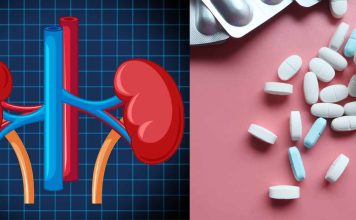Table of Contents
What is a Deviated Septum?
A deviated septum occurs when the partition in your nose displaces on a particular side rather than staying in the middle.
It’s a common scenario, and the major complication caused by a deviated septum is the compression of the nose due to smaller nostrils. In case of a deviated septum, one of your nostrils will be larger, and the other will be smaller. This smaller nostril causes most of the complications.
When a deviated septum is severe enough, it can completely block one side of a nostril and cause difficulty breathing. Sometimes, the septum does not close the nostril, but the mucus and some substance get stuck and cause congestion.
Some people may experience bleeding through the nose in a severe deviated septum. The medical term of this phenomenon is known as epistaxis.
Sometimes the deviated septum occurs due to inflammation in the mucous membrane of the nose. the inflammation of the mucous membranes of the nose causes swelling mucus, and death blocks the nostrils.
Some common symptom of a deviated septum is snoring, difficulty breathing, pain in the nose, etc.
Deviated Septum Symptoms
The symptoms of a deviated septum vary from person to person. Some common symptoms of a deviated septum occur in most people.
Obstruction of the Nostrils
the primary symptom of a deviated septum is obstruction of one or both nostrils. It usually obstructs the narrow nostril. The affected person may feel difficulty in respiration. Cold and certain allergies can worsen the situation.
Bleeding Through the Nose
nose bleeding does not occur in every person. It usually occurs when the deviated septum is more severe, and one of the nostrils is closed and infected by a virus or bacteria. The inflammation in the infected nostril may cause bleeding.
Dryness of the Nose
sometimes the affected nostril may become dry because there is not enough healthy mucous membrane to release some substances to make the nostrils more clean and wet. This situation may result in the dryness of the nostrils and cause more irritation.
Facial Pain
Facial pain is quite a common symptom of a deviated septum. Sometimes the person may feel pain in one side of the face where the deviated septum is situated. Pain around the nasal area is more common than pain in the whole facial area. Sometimes the area around the nostrils is red and tender.
Snoring
snoring is a common symptom of a deviated septum. Snoring occurs due to small nostrils and air passage out of it. Noisy sleeping is also one of the symptoms of poor sleeping.
Nasal Irritation
nasal irritation is also a common symptom of a deviated septum. It is characterized by always an awareness of the internal condition.
The person cannot just forget that the nose is a normal organ; they always feel some irritation inside the nose. It occurs because one of the nostrils is congested and blocked and is caused irritation.
Sleeping on a Particular Side
The person having a deviated septum prefers to sleep on a special side to breathe effortlessly.
This symptom is helpful to detect a deviated septum in children. The parents may notice that the children are sleeping on a particular side. Even if you put him on another side, they go back to their natural comfort side.
Putting the Finger Inside of Nose
it is a symptom of a deviated septum in children. A child with a deviated septum puts his finger on the nose to clear his nose. difficulty breathing or often getting out of breath during crying is also a symptom in children.
Loss of Smell
as one of the nostrils is closed, the affected person cannot smell a substance properly. It does not occur in every person with a deviated septum. It occurs mostly in those people who are also suffering from nasal congestion.
Read Weight Loss Affect on Nose
Deviated Septum Causes
Several causes are responsible for developing a deviated septum. Some common causes may include;
- Congenital: in most cases, a diverted septum presents after the birth. It occurs due to some developmental anomalies.
- Injury to the nose: A septal deviation can occur due to an injury to the nose. it can occur to sportspersons, physical workers, and other professionals.
The children are vulnerable to a septal deviation because their nasal septum and nose structure are not that strong during childhood. They get a deviated septum due to fighting or fall into the ground.
- Aging process: A septal deviation can occur in some people during the aging process. in this case, the person does not have it during their early life, but they may have a septal deviation after 50 to 60 years of age.
- Irritation of the nose: swelling and nose irritation is another cause. Irritation of the mucous membrane causes the increasing size of the mucous membrane. So the inflamed mucous membrane causes congestion and blockage of the nostril rather than the septum itself caused it.
- Trauma: nasal trauma during automotive racing or vehicle accident is quite common nowadays.
Risk Factors
A deviated septum occurs during fetal development in the mother’s abdomen in most people. The pregnant mother had to maintain a healthy lifestyle to get a perfect baby without anomalies.
Participating in extreme physical sport may cause septal deviation.
Not wearing a seat belt or taking enough precautions while driving a vehicle is also a risk factor.
Complications
The complication of a septal deviation may vary. The common complications may include;
- Difficulty breathing: breathing difficulty is the most common complication of a septal deviation. It occurs because of the blockage of one of the nostrils. The person cannot breathe effortlessly and is always stay concerned about respiration.
- Dry mouth: dry mouth is also quite a common complication. It occurs because the affected person tries to breathe through the mouth rather than the nostrils. Those who breathe through the mouth are known as mouth breathers.
Breathing through the mouth leads to dry mouth, smelly mouth, and other complications.
- Sleep disturbance: sleep disturbance is a common and depressing complication. As the person with the deviated septum cannot breathe air effortlessly, they cannot sleep well.
- Snoring: snoring occurs because of the condition of the nostrils. It can also occur by the inflammation of the mucous membrane of the nose.
- Infection in the nose: There can be bacterial contamination and infection if one of the nostrils is congested. The infection may lead to some other complications.
- Bleeding: bleeding occurs due to chronic inflammation in the mucous membrane of the nostrils. When the mucous membrane is irritated and inflamed, bleeding can be through the affected nostril.
Diagnosis
Diagnosis of the deviated septum is mainly clinical. The doctor may examine your nose and nostril to get a view of the deviated septum. The doctors often use a torch and scale to measure the septal severity.
Sometimes the doctors may advise you for an X-ray or other radiological examination to know more about the structure of your nose.
Take all of your medical documents when you go to the doctor or examine your deviated septum.
The septal deviation is examined and treated by an ENT specialist.
Read Deviated Septum Self Test
Deviated Septum Non-Surgical Treatment
The most common treatment of a divided septum is surgical, known as septoplasty. But there are other methods that one could try and see if they can get rid of a septal deviation or the complications of a deviated septum without surgery.

Nasal Spray
deviated septum raises some common complications such as difficulty breathing. Difficulty breathing and some other complication occur because the mucus and some substance of the nose get trapped in the smaller nostrils.
A nasal spray can help you get rid of trapped mucus and other substances in the nose. Use a nasal spray with caution because it can cause dependency in prolonged use.
You should not use a nasal spray if there are any signs of bleeding through the nose or have experienced allergy after using a nasal spray.
Antiallergy Medications
the complication of a deviated septum increases if the inflammation occurs in the smaller nostrils. If you are also suffering from an allergic reaction and few have a deviated septum, you may use antihistamine as an anti-allergic medication.
Antihistamines help you to get rid of allergic reactions. There are two types of antihistamines;
- The first-generation antihistamines cause a common side effect of drowsiness or dizziness.
- The second-generation antihistamines do not cause dizziness or drowsiness. So it’s your choice to do the best for you.
Nasal Strips
nasal strips are more like a bandage. You can attach the nasal strip on the outer margin of your nostril and keep them away from the nasal septum. You don’t have to wear nasal strips all over the day. You may wear them at night.
Nasal strips help you get rid of snoring, and it helps to increase the airflow through your nose during the night.
Nasal strips also help to lift the outer margin of your nose from the septum and thus increase the size of the nostrils.
Nasal Dilators
Nasal dilators are mechanical device that helps keep your nostrils wide open. There are two types of nasal dilators;
- Internal nasal dilators push the nasal septum and keep your nostrils wide open.
- External nasal directors pull the outer margin off your nostrils outward to keep your nostrils wide open.
Nasal dilators with some mechanical device and later completely user friendly so you can try them on.
Nasal Valves
Nasal valves are placed inside your nostrils to keep them open. They are also mechanical devices and are not noticeable from the outside. The user experience of nasal valves is pretty good.
Nasal Irrigations
Nasal irrigation is a system, and a Neti pot does that. You have to put some saline solution in the neti pot and pour it into the nostril. This solution clears your nose and helps you to breathe effortlessly and get rid of the complication of a deviated septum.
The benefits of nasal irrigation:
- Help you to get rid of stuck mucus
- Help to boost your immunity end increase the effectiveness of the cilia
- Relieve the sinus pressure
- prevent infections
- improve the mucosal regeneration
- helps you to breathe properly
- no side effects
Nasal irrigation works best for children. The newborn babies cannot eat or drink medicines. So, nasal irrigation by a Neti pot can be useful whenever they suffer from nasal congestion or runny nose.
Nasal irrigation cautions
- Use warm water
- use new saline solution
- clean your Neti pot before, and after every time you use it
- Use filtered water rather than using unfiltered tap water.
Water Vaporizers
The water vaporizers help to increase the humidity of the air. You may notice we often experience a runny nose and other allergic reactions during the winter. It’s not only for the cold but also the dryness of the air is responsible for it.
Water vaporizer helps keep your nose and respiratory tract moist and prevent getting dry. If you use a room heater or car heater, you should use a water vaporizer.
Taking hot water pepper can help you get rid of nasal congestion and stuffy nose. hot water vapour also helps you get rid of sinusitis.
If the children are experiencing nasal congestion, use water vaporizers to relieve their irritation and pain.
Avoid Irritants and Allergens
Most people with septal deviation can lead a normal life without treatments. But the complication occurs when some external factors are exaggerating it.
The external irritants and allergens may increase the allergic reaction of your body and causes nasal congestion and a stuffy nose. preventing exposure to the allergen may help you get rid of these symptoms.
The prevention method may include;
- Use a surgical mask
- clean your house properly
- avoid wool and pollens
- clean your room heater filters
- make your room dust-free by using a vacuum cleaner
Surgical Treatment
in the deviated septum surgery, the doctor corrects the position of the nasal septum to fix the deviated septum; this surgical procedure is known as septoplasty.
In a septoplasty procedure, the doctor may need to remove certain parts of the septum and reinsert them to fix the septum’s position.
Septoplasty is an easy procedure, and there are not many complications. You may notice the improvement a few days after the surgery, and the nasal structure and consumption can go away after the surgery.
Most of the time, septoplasty remains with the ageing process; you don’t have to undergo another surgery in your lifetime.
In some cases, the debated septum is related to the underlying bone structure. In that case, the doctor may also have to correct these Bony alignments.
Reshaping the nose is known as rhinoplasty. It’s a surgical procedure, and in this procedure, the doctor performs surgery on the overall nose to get it in perfect shape.
Sometimes you may undergo both septoplasty and rhinoplasty to get the best result out of it. Your doctor will discuss it with you during the consultation.
Takeaway
although the most common treatment procedure for a deviated septum is septoplasty, a surgical procedure. There are some methods available other than surgery to fix the deviated septum.
If your condition is not that severe and you are not experiencing nose bleeding or other major complications, you may try those home remedies.
Septoplasty is a well-accepted method for treatment of the deviated septum. So if you are not feeling well after following the non-surgical methods, consult with your doctor and undergo a surgical procedure to get rid of the septal deviation.
Frequently Asked Questions (FAQs)
What is a septum?
Nasal septum is the thin partition inside your nose.
How much is deviated septum surgery?
Septoplasty costs around $5000 to $12000. It depends on the location, surgeon and many other factors.
How to fix a asymmetrical Nostril?
The surgical procedure of fixing the nasal asymmetry is known as rhinoplasty.
Last Updated on April 6, 2022 by Learn From Doctor Team





